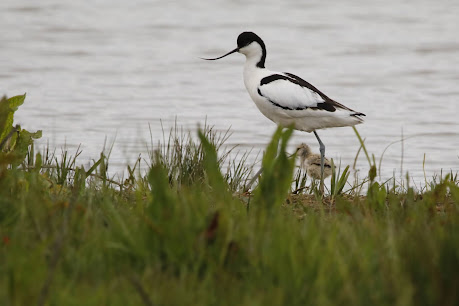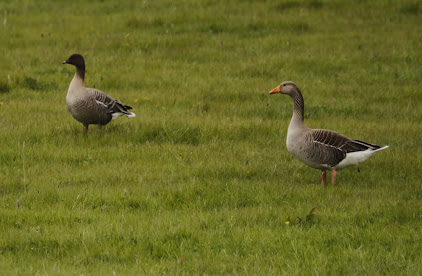Being a bird watcher I have a fondness for remote marshes, windswept, desolate and devoid of people, nothing better than having the wind and rain driving into my face as well. There's something mystical, primordial, and poetical about hose places. However these places are just as man made as any other piece of land, and are most often nature reserves. Hollesley Marshes and its nearby sister reserve Boyton Marshes, both managed by the RSPB, fit that description quite neatly, two small areas of protected land lying off the beaten track. The reserves sit along the Alde Estuary, areas of marshland that attract lots of waterbirds, and are very important places that protect this feeling of remoteness as well as the birds.
Being RSPB reserves these are good places for birds and I saw a good variety of a large number of birds. At this time it is still the peak of Spring migration, and there were a lot of migrants present today.
Hollesley Marshes
Being remote, Hollesley is home to a high security prison, with no where for escaped convicts to run to except desolate marshlands. The area is a fairly new reserve, one not really advertised, and so is only really known by a few local birders. A car park and a viewing screen are the only facilities, however, by the car park, as part of the prison, is a café, run by veteran volunteers. Its so out of the way, so you wonder how it will make money, but is worth a look if in the area, starting the days' watching with a nice warm coffee.
The Reserve consists of a large area of wet grassland, with the centrepiece being the large scrape. A shallow area of water amongst the grass, its not as popular to birds as the Scrape at Minsmere, so there aren't the huge number of gulls and terns. I was looking for migrant WADERS, as spring migration was still at its peak, but the only birds present were the breeding birds. LAPWING and AVOCET were here, present in the largest numbers, with members of both species sitting on eggs. In smaller numbers were REDSHANK and OYSTERCATCHERS breeding birds in smaller numbers.
What was quite evident was how beneficial the scrape was to both CANADA and GREYLAG GEESE. There must have been over 25 broods numbering over a hundred gosling, that's one hell of a gaggle! The usual DUCKS were present, with a few SHOVELLER, GADWALL and SHELDUCK, with a couple of WIGEON and TEAL remnants of the winter.
Bird of the day wasn't the rarest, but is one of the most charismatic. A CUCKOO was first heard singing from the viewing platform, on the sheep grazed higher ground behind the marshland. Then when we got to the river wall, what most have been another bird dashed along the concrete bank chased by a pair of MEADOW PIPITS, one of their parasited species. In flight the cuckoo has sharp wings and a long tail and resembles a bird of prey. This species is one of those I used to hear commonly throughout the countryside when I was a boy but has become quite rare and restricted to few places nowadays, mainly reserves like Hollesley.
A female MARSH HARRIER drifted over the scrape, under constant aerial attack from the nesting avocet and lapwing, a characteristic bird of the Suffolk coast.
After leaving Hollesley Marshes, and then passing the Suffolk Punch Centre, a flock of 24 FALLOW DEER were seen nonchalantly grazing the pastureland. With them were a small number of JACKDAWS feeding on their backs, pecking away at their lice and other parasites on their coat. Some of the deer had newly grown antlers covered in velvet, still a long way from the autumn rut.
Boyton Marshes
Boyton is similar to Hollesley, although it has a much smaller scrape, but more areas of grassland managed as a farm, with cattle grazing the pastures. It is full of world war two architecture, pill boxes and anti tank blocks, which make the flat marshes very picturesque.
The scrape at Boyton is fairly small, but the area was bursting with birds. AVCOET were the star birds, with around twenty pairs present crammed in on the islands, including the first chick of the season, keeping close to its parents. Also present was a small colony of BALCK HEADED GULLS, and a small number of GADWALL, SHOVELLER and SHELDUCK, which may nest here. By the scrape was a flock of five YELLOW WAGTAILS. Once common birds that nested in places like this, they are rapidly declining, and are becoming hard to see, so were a nice spot today.
The path cuts through the reserve to rise up to the river wall at Butley Creek, a tributary of the tidal river Alde. Where the path meets the river there is a pill box, one of the many architectural remnants from the war. Around here was a GREENLAND WHEATEAR, characteristically perching on a fence post, flying off and exposing its white rump. These birds are a variant of our own wheatear, but are slightly larger and more colourful, and as well as being a later migrant, appearing during May. A HARBOUR SEAL was on the river here, these animals are one of my favourites, they swim in from the sea looking for fish on the river. The tide on the river was high, and unfortunately I didn't see any waders, just a couple of GODWITS. On the landward side, a HOBBY graced us as it hunted over the marshes, on the lookout for a stray swift or swallow to catch.
The grassland covers a large proportion of the reserve, and though it can be quite featureless, does attract some birds. An over summering PINK FOOTED GOOSE was hanging around with a flock of greylags, lost birds tend to hang around with similar species. Pink feet winter in small numbers in the area, and for some reason this individual got left behind, while the rest left for their breeding grounds. A GREAT WHITE EGRET was seen in flight before landing and hanging around in a ditch a fair distance away, my first record of the bird at Boyton, but I doubt will be my last. The size of herons, these big all white birds have a large yellow bill and all black legs, in contrast to its stark plumage.
The ditches that cut their way through the reserve are a haven for wetland birds and the reed fringes prove just as popular. On the large ditch next to the river wall, two pairs of SWANS were nesting. With one pair, the cobb (the male) was seeing off a third pair which were maybe prospecting in their area. As anyone who has any experience with swans, they can be quite vicious when it comes to projecting their nests. The battle took place on the river, as the cobb on territory took his fury out on the other male, causing the intruder to ungracefully take off.
The reed fringes were alive with REED BUNTINGS and both SEDGE and REED WARBLERS their agitated scratchy songs, ringing out from the ditches.
After leaving Boyton, near the steel sculpture, a pair of YELLOW WAGTAIL were disturbed from drinking from a puddle. A few pairs probably still nest in the area, on low crops, like cabbage or peas, on low lying land.
Later on, whilst driving through Aldeburgh, I was astounded to see a SPOONBILL fly over. This bird is like a heron, but in flight has an extended neck, and with its distinctive beak, it could be no other bird. Its now fairly common in the area, on the river Alde and North Warren, as well as having recently started nesting on Havergate Marshes, it was just unexpected to be seen over a busy little town.
Suffolk is blessed with so many good nature reserves, and Boyton and Hollesley aren't even the main ones. With so much remoteness, which has allowed so much of the area to survive as wilderness and as reserves, as land managed just for wildlife. The Suffolk coast is so unique, and is one of the few places in lowland England to still have this solitude, something that despite being so intangible is still very important.














No comments:
Post a Comment